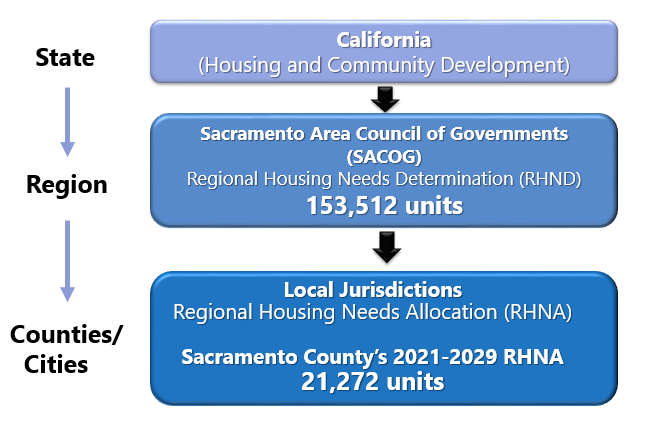Housing Action Plan Program A5 of the Sacramento County Housing Element of 2021-2029 (Housing Element) identifies that the County will evaluate the need and ability to increase minimum densities of multifamily land uses in approved plan areas to accommodate the lower-income Regional Housing Needs Allocation (RHNA) at the required density of 30 dwelling units per acre.
The County initiated this effort in the fall of 2021 and conducted property owner and public outreach in spring/summer of 2022. However, progress on this Housing Action Plan paused in the winter of 2023 to prioritize completing the Countywide Rezone Program (Housing Action Plan Program A1) by the State-mandated deadline.
Now, in pursuit of Housing Action Plan Program A5, the County is undertaking the rezone of sites in the East Antelope Specific Plan, Florin Vineyard Community Plan, North Vineyard Station Specific Plan, and Vineyard Springs Comprehensive Plan to accommodate the lower-income RHNA in these approved plans. Development in the three approved plans areas in the Vineyard community and recent planning activities in the East Antelope Specific Plan have progressed to the point where it is timely to increase multifamily land use densities to align with State housing law and provide for a broader mix of housing types in these plan areas.
This effort is partially funded by the U.S. Department of Housing and Urban Development (HUD's) Pathways to Removing Obstacles to Housing (PRO Housing) grant. The project timeline provided below is subject to change, dependent on federal grant administration and related processes.

FAQs
Nothing. Neither the property owner nor the County are required to build the units estimated to be provided on the Land Inventory. If you sell the property or choose to develop it as multifamily, you or the future owner/developer will be required within the density range identified by its new zoning classification.
You can view the locations of all the candidate rezone sites in the map below. You can also download a PDF of this map.

The State has outlined criteria for vacant sites to be designated as suitable for housing development affordable to lower-income levels:
- Sites must be at least 0.8 acres, but less than 10 acres.
Have existing access to infrastructure (e.g. water, sewer, dry utilities)
Be in close proximity to services (e.g transit opportunities, parks, commercial centers)
The County is prioritizing sites that already allow multifamily development; many of the sites proposed for rezone already allow a housing density of 20 units per acre, but must allow 30 units per acre to satisfy the lower-income RHNA.
The County has is also committed to rezoning sites in moderate, high, and highest-resource areas to affirmatively further fair housing choice. More information on the requirement to affirmatively further fair housing can be found on the California Department of Housing and Community Development Department's (HCD's) website.
The RHNA is a minimum projection of additional housing units needed to accommodate projected growth of all income levels by the end of the Housing Element’s planning period.
Every eight years, HCD provides Sacramento Area Council of Governments (SACOG) with an amount of dwelling units the region must plan for. SACOG is then responsible for allocating these units to each city and county within its region. Each jurisdiction then adopts a Housing Element that demonstrates how they can accommodate their RHNA units in their zoning.

More information on SACOG’s process for RHNA calculations can be found on their website.
Sacramento County’s total RHNA for 2021-2029 at
all income levels is shown below.
Income Category
| Number of Units
| Percentage
|
|---|
Lower-Income
| 7,158
| 33.6%
|
|---|
Moderate-Income
| 4,186
| 19.7% |
|---|
Above Moderate-Income
| 9,928
| 46.7%
|
|---|
Total
| 21,272
| 100% |
|---|
Lower income is inclusive of the low, very low and extremely-low income categories. These following income ranges are based on a percentage of Sacramento County’s average median income:
Extremely Low-Income
| $0 - $25,900
|
Very Low-Income
| $25,901 - $43,150
|
Low-Income
| $43,151 - $69,050
|
Moderate-Income
| $69,051 - $103,550
|
These are based on the “opportunity index” maps prepared by HCD and the California Tax Credit Allocation Committee (TCAC). The maps are intended to display the areas that, according to research, offer low-income children and adults the best chance at economic advancement, high educational attainment, and good physical and mental health.
The primary function of TCAC is to oversee the Low-Income Housing Tax Credit (LIHTC) program, which provides funding to developers of affordable rental housing. The opportunity maps play a critical role in shaping the future distribution of affordable housing in areas with the highest opportunity.
A map showing the opportunity index of the unincorporated areas of the County can be found on the CTAC/HCD Opportunity Area Maps webpage.
